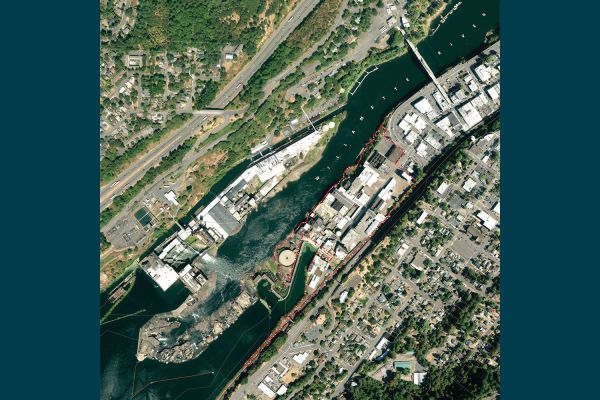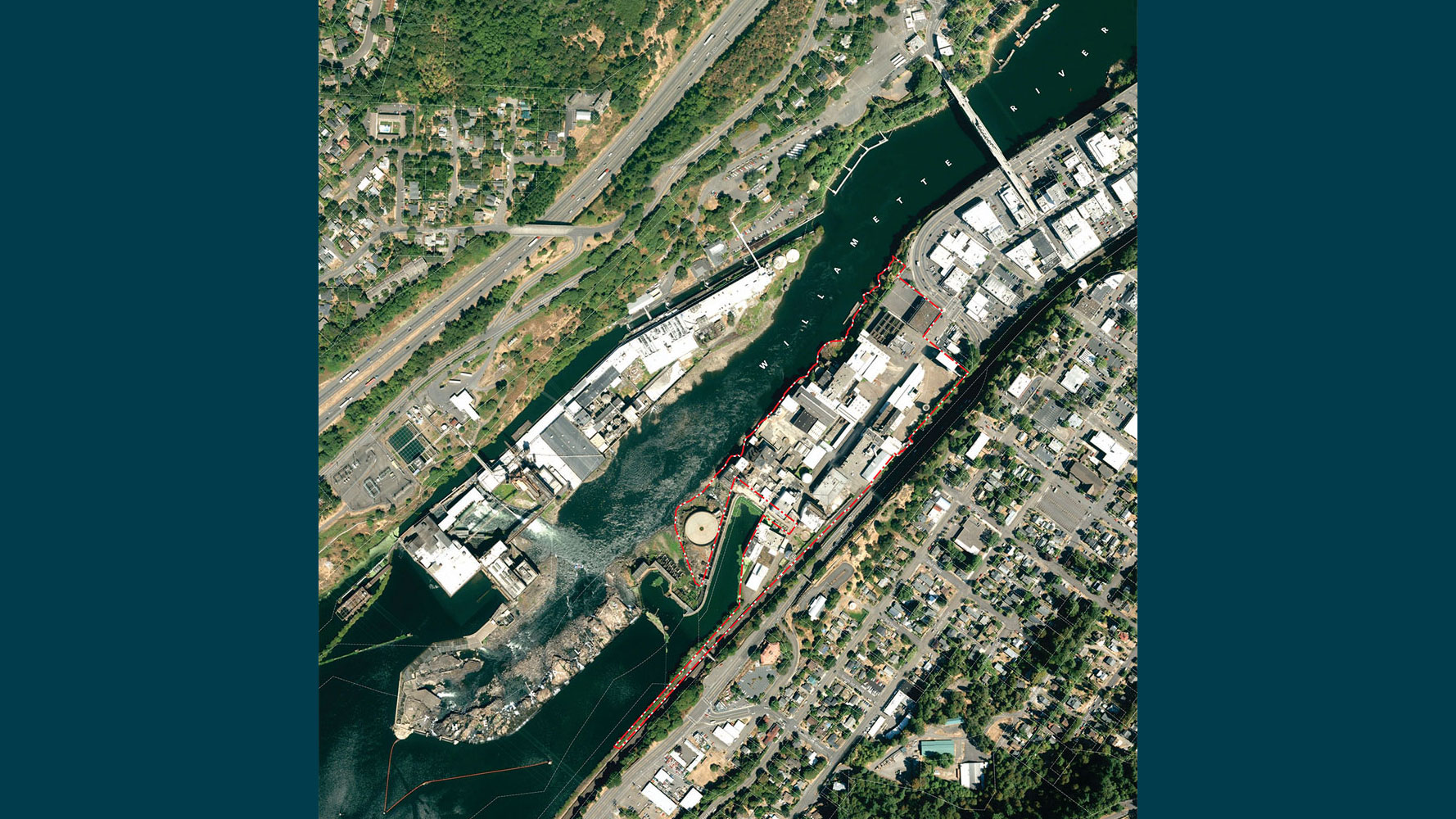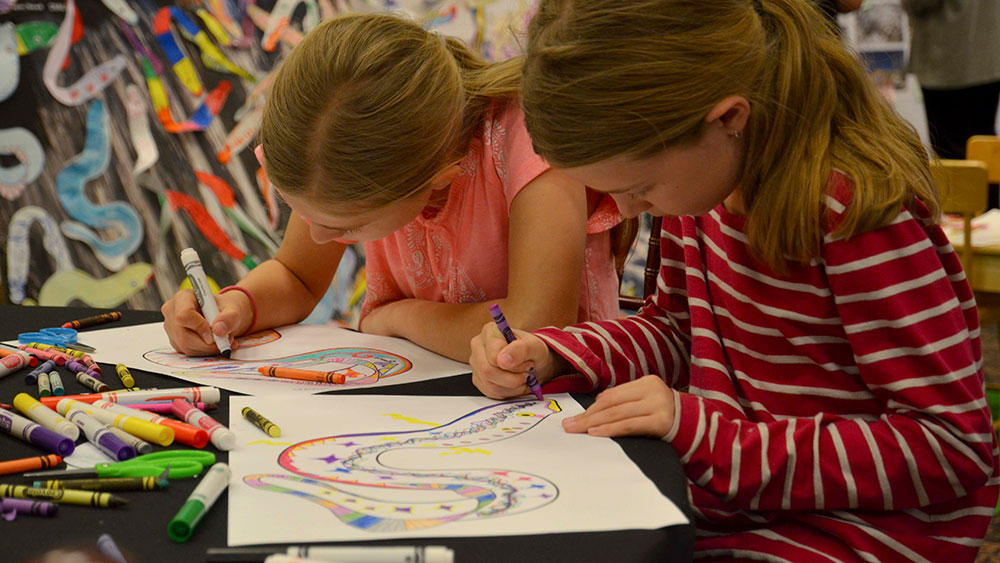In this online event, you will get to see and experience the activities from the community event in Oregon City on March 30th. The six stations below allow you to see what people have already shared and add your own ideas. Riverwalk designers will see what you’ve shared and consider the range of ideas and the project's Core Values to begin the design process.
Thank you for your interest in Willamette Falls Riverwalk Schematic Design and for participating today!
Stations
Note: It may take up to 20 minutes to participate in all of the stations.
Project Area
Willamette Falls is important to Oregon’s history. This site has a rich history of industry, important to the culture of Native Americans who have been fishing and gathering there since time immemorial, and is a critical habitat for fish, birds and animals. The creation of a Riverwalk will open up Willamette Falls to the people, allowing residents and visitors alike a close-up view of the second largest waterfall by volume in the United States.
For the next two years, the project will engage in the design of the riverwalk. This includes determining the character and the public access alignment of the riverwalk, placement of viewing overlooks, selection of materials, areas of habitat enhancement and development of an overall design before we move into detailed design and eventual construction. The Riverwalk will catalyze and integrate with future development.
Design Team
The design team is composed of designers from Snøhetta, Mayer/Reed, and DIALOG.
More Information
- Willamette Falls Legacy Project Fact Sheet (pdf, 2.9 MB)
- Willamette Falls Legacy Project Fact Sheet - (en español)(pdf, 2.9 MB)
- Meet the Design Team/Project Schedule (pdf, 2.3 MB)
Instructions
- Review the images in the PDF.
- Once you're done reviewing the images, answer the questions below.
Interpreting the Data
The width of each connecting line is proportional to the number of connections between images as assigned by the public at the March 30th event and through the subsequent online survey.
- Download a pdf of the Connect the Dots image wall (pdf, 2.9 MB)
Weigh in...






Instructions
- Select three images that inspire you and one image that represents a concern or worry you may have for the Riverwalk. Remember the corresponding image numbers.
- Once you're done reviewing the images, answer the questions below.
Interpreting the Data
The size of each image is proportional to the number of positive responses as assigned by the public at the March 30th event and through the subsequent online survey. The opacity of the red background is proportional to the number of negative responses.
Download a pdf of the Image Inspiration image wall (pdf, 1.6 MB)
Results from March 30th
(Does not include results collected online.)
Weigh in...




Your Questions...
History
When was the dam built?
Dams have been in place since the early days of European settlement in Oregon City for three main purposes: milling, creating infrastructure needed for shipping, and for generating electricity. The first reference to a dam comes in 1852 when it was mentioned along with other infrastructure associated with a dock for the steamboats. The "dam" has been rebuilt several times. For example, in 1866, a larger dam was made to enclose the basin, in 1892 the dam was rebuilt so that it reached across the entire length of the river from Station A, and in 1907 the wood crib dam was replaced with a new concrete structure.
Which tribes use the falls?
The Willamette Falls has been a special part of Tribal history. Native people from across the region visited and lived near the falls. The falls played an important role in trade, fishing, hunting, and gathering of native plants. As part of the design and interpretive efforts of the Willamette Falls Legacy project, outreach is ongoing to; the Confederated Tribes of the Grand Ronde, Confederated Tribes of Siletz Indians of Oregon, Confederated Tribes of the Umatilla Indian Reservation, Confederated Tribes of the Warm Springs, and the Confederated Tribes and Bands of the Yakama Nation. The project team is working to identify ways that the story that is told about tribal use and rights to the falls is appropriate, respectful, and relevant. It is important that the project take into account the historic uses, treaty obligations, and resource protection of the natural and cultural resources of the area.
Hydrology
When were the locks last used?
The locks were completed in 1872 and were transferred to “non-operational” status for life safety reasons in 2011.
Is the riverwalk in a flood plain?
A portion of the 22 acre property is within the 100-year floodplain. The route of the Riverwalk has not been determined, but portions of the Riverwalk may be within the floodplain.
Is the West Linn portion of the site included in the project?
The Riverwalk design effort is focused on the 22 acre Blue Heron property and the portion of the PGE dam on the Oregon City side of the river.
Habitat
Do lamprey still use Willamette Falls?
Yes! Lamprey migrate upriver through Willamette Falls using a series of fish ladders and ramps generally from late June through July.
What are lamprey used for?
Pacific lamprey are one of the oldest fish found in the Willamette River and are valued as one of the “First Foods” by Northwest tribes.
Are the lamprey in trouble or in decline?
Populations of lamprey have been in decline over the past several decades.
Do people fish on the river? What do they fish for?
Yes! Some common species are Chinook and Coho salmon, steelhead and cutthroat trout, sturgeon.
Economic Development / General
Are there examples of other projects like this one?
There is nothing quite like what we have in Oregon City – a combination of falls, industry, history, and nature. While there is a wide range of projects that have some similar elements, we provided brief list of some of them:
- San Antonio Riverwalk, San Antonio, TX
- Mill Ruins Park - Minneapolis, MN
- Mill District – Bend, OR
- Landschaftspark – Duisburg-Nord, Germany
What is the timeframe for this project?
This design phase will be completed in approximately 18 - 24 months. Permitting and construction of the first phase will take approximately 2-3 years to complete.
When will the Riverwalk be completed?
Construction of the Riverwalk will be completed in phases. Funding for a first phase of the Riverwalk has been secured. Additional fundraising will need to be done to complete the remaining phases.
How can I access the falls today?
There is no open public access to the falls at this time. Information about site tours can be found at www.rediscoverthefalls.com
Who currently owns the site?
There are two property owners for the project site. Falls Legacy LLC owns the 22 acres of the former Blue Heron Paper Mill property, and Portland General Electric owns the dam.
We received many comments and ideas for the Riverwalk.
These are just some of the themes that we heard…
- Access to Willamette River
- Anchor Use
- Arch Bridge
- Art
- Artifacts
- Benefits For Oregon City And West Linn
- Bikes and Pedestrian Access
- Birds, Owls, Eagles, Swifts, Osprey, Blue Heron
- Boat Tours of Willamette Falls
- Business / Employment Opportunities
- Camassia Nature Preserve
- Canemah Neighborhood
- Children’s Education
- Cloud Software
- Commercial Kitchen Rental
- Community Garden
- Commuter Rail
- Concern about gentrification
- Creative Space
- Dickman Mill Park (Tacoma)
- Economic Self-Sufficiency
- Educational Opportunities
- Educational/ Interpretive Signage
- EMT Training
- Exhibits
- Existing Privately-Owned Dock
- Fish Ladder
- Fish Migration
- Fish Viewing
- Flood Plain And Flooding
- Freight Movement
- Frequent Bus Service
- Funding
- Fundraising
- Glass Cover For Walkway
- Habitat Restoration /Improvement/ Reintroduction
- Harmonize Uses
- Historic Buildings
- Hotel
- Industrial History
- Innovative Jobs
- Involve School-Children
- Iron history (first use in concrete building)
- Kayaking
- Lamprey
- Live And Work Community
- Main Street
- Manufacturing Jobs
- Motorized Boats Beyond The Arch Bridge
- Mural
- National and International Events
- Native People
- Native Plants
- Natural Space
- Net Fishing / Dipnetting
- Olympic-Level Training Center
- Oregon Weather
- Overdevelopment
- Paddleboards
- Parking
- Parking Garage
- Permanent Housing
- Petroglyphs
- Playground
- Portland General Electric Dam
- Private Development
- Project Schedule
- Promenade
- Quiet Zone / Train Horns
- Recreational Access
- Restaurants
- River Place in Portland
- River-Level Window
- Secluded Area
- Senior Housing
- Sense Of Place
- Site Electricity Generated By The Falls
- Site Ownership
- Site Remediation
- Site Tours
- Small-Scale Production
- Streetcar / Trolley
- Sturgeon
- Traditional Ceremonies
- Traffic
- Trail Connections
- Unique Opportunity
- Vegetation
- Vibrant, Active Space
- Videos / Media
- Water Rights
- Water Taxi
- West Linn
- Whitewater Park
- Wildlife
- Willamette Falls Locks
- Zipline / Ski Lift / Tram / Gondola
You can also view ideas that were submitted last month through a community survey here.
Schedule
Stay Involved
Mailing List (Optional)
Provide the following optional contact information if you would like to be added to the project mailing list.

About the Project
The Willamette Falls Legacy Project is a partnership between Oregon City, Clackamas County, Metro, the Governor’s Regional Solutions Team, Falls Legacy LLC and thousands of interested citizens. For more information, email info@rediscoverthefalls.com.









